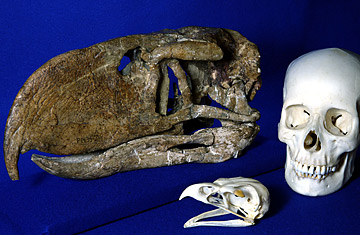
A fossil skull of the terror bird Andalgalornis is compared with the skull of a modern-day golden eagle and a human skull for scale.
The term mid-size terror bird sounds kind of bizarre at first, as though terror birds, whatever they might be, come in a range of sizes, all of them a bit scary — sort of like coffee options at Starbucks. Actually, they do — or did, anyway. From about 60 million years ago, when they arose, until they went extinct 57 or so million years later, the family of birds known as phorusrhacids spread across South America, ultimately becoming the continent's dominant predator and producing 18 distinct species of big-headed, hook-beaked, flightless predators that could reach 10 ft. in height. If a phorusracid had its beady eye on you, terror would be the appropriate emotion.
Just how a terror bird would go about killing its prey, though, has been unclear, and since the birds' only living descendants — the sereimas, a South American predatory species that subsists on insects and lizards — don't really resemble them much, scientists have to deduce their behavior from the fossils they left behind. A few years ago, for example, South American researchers studying the birds' leg bones concluded that some could have run up to 60 m.p.h. and kicked with shattering force.
Now a new study has appeared in the journal PLOS One arguing that the mid-size terror bird Andalgalornis steulleti attacked like an axe murderer — the axe in this case being its massive skull, more than a foot long on the 4 -ft.-tall, 90-lb. bird. The authors, from Argentina, Chile, Australia and the U.S., came to this conclusion through an exhaustive analysis, using CT scans and comparisons with modern birds to determine what the skull would have been good for.
Not biting, evidently: the scientists used a bite meter to compare the chomping power of an eagle and of a seriema, a not-very-terrifying modern relative of the extinct bird. Using those results, they estimated what Andalgalorniss bite would have been like, and concluded it wasn't the bird's most effective weapon — since it was simply too weak to kill. Beyond that, a computer model of the 6-million-year-old skull revealed that Andalgalorniss could withstand enormous forces in the front-to-back direction — in part because the bones were fused tightly together where many modern birds have more flexible connections — but the skull was less resilient when it was moved side to side. If it bit into its prey and held on, too much thrashing could thus have broken its beak. Add to that the fact that Andalgalornis had powerful neck muscles, and it's reasonable to deduce that an attack would likely have consisted of a series of darting, hacking maneuvers, with the curved beak ripping out a bit of flesh each time, for good measure.
When the phorusrhacids first arose, South America was completely surrounded by water; by the time the birds disappeared, plate tectonics had welded the continent to North America. That gave the birds a chance to invade the newly attached land mass to the north, and at least one species, an 8-footer called Titanis walleri, did just that. By the time humans arrived from Asia, fortunately, terror birds had long since disappeared from both continents. The reasons aren't completely clear. One theory has it that the land bridge to North America worked both ways, and big mammalian predators, such as saber-tooth cats, moved south and wiped them out. It's just as well.
